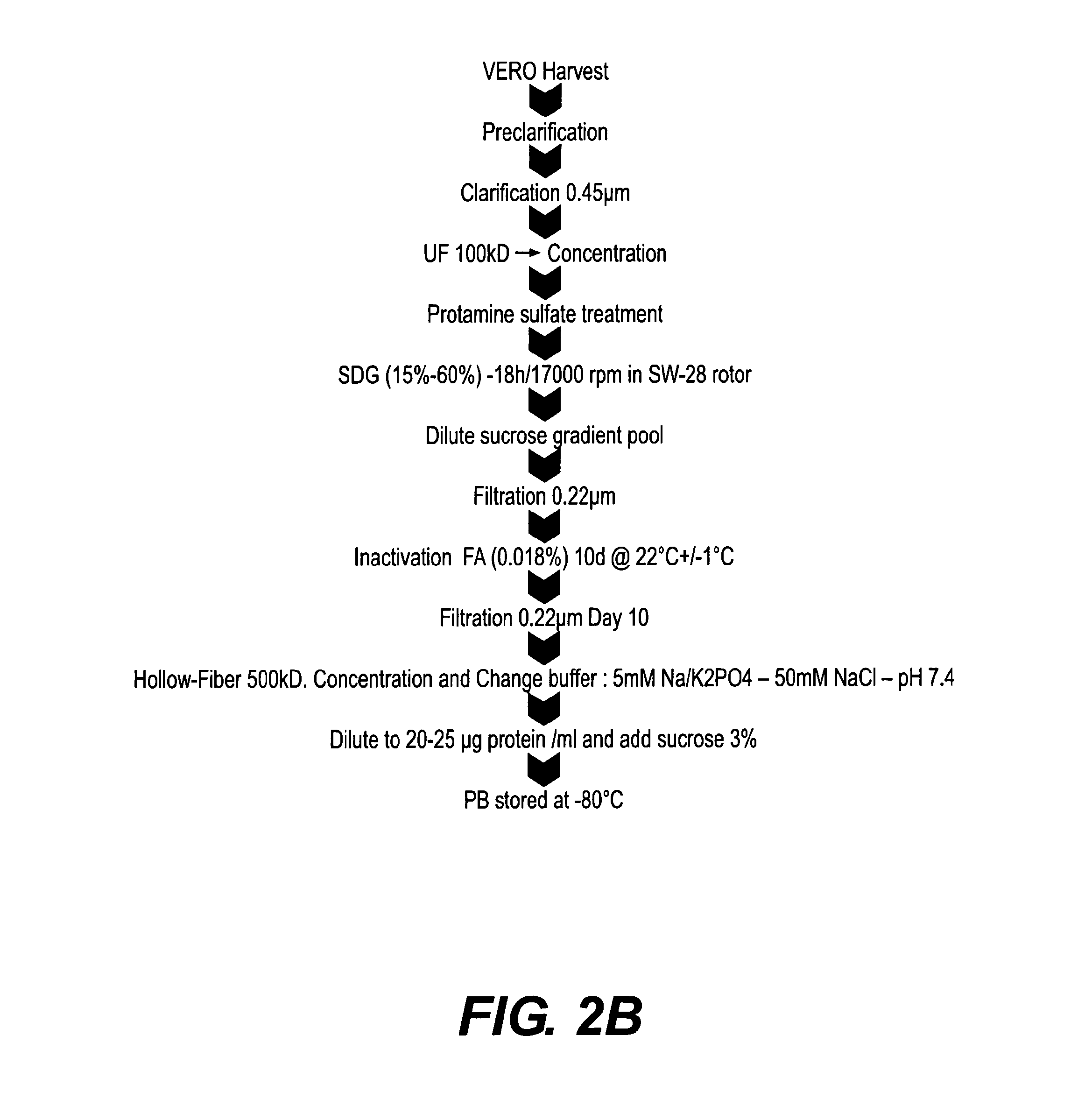Inactivated dengue virus vaccine
- Summary
- Abstract
- Description
- Claims
- Application Information
AI Technical Summary
Benefits of technology
Problems solved by technology
Method used
Image
Examples
example 1
Purification Process for Producing Purified Inactivated Dengue Virus
[0119]Dengue virus is grown in Vero cells and purified essentially as described in WO 2010 / 094663. For example, Dengue virus is grown in Vero cells, e.g., in animal free medium. Typically, the cells are maintained in a stationary preculture phase (e.g., in T flasks or a cell factory), in an animal free (AF) medium, such as the commercially available VPSFM medium from Invitrogen. The cells are then expanded in a bioreactor, typically attached to microcarriers (such as Cytodex 1), and fed by either perfusion or batch modes. Once the cells have reached a suitable density, the cells are infected at suitable MOI (e.g., 0.01-0.1, for example 0.05) with virus, either in serum-containing (e.g., 1.5%) or AF medium. When employing serum-containing medium, after an initial infection phase (typically of approximately 2 days), the medium is typically exchanged to AF medium. Optionally, the AF medium is initially or periodically ...
example 2
Formulation of Exemplary Immunogenic Compositions
[0124]Formulation of purified inactivated Dengue virus was assessed under different conditions to solve the problem of loss of product during storage, lyophilization and subsequent handling. The following variables were evaluated in the formulation of the bulk preparation of inactivated Dengue virus (3.3 μg / ml per strain): Phosphate buffer (pH 8.5) concentration (5, 15, 30 mM), poloxamer surfactantconcentration (0, 0.001%, 0.2%), in the presence of 5% sucrose, 25 mM NaCl in water for injection. The bulk was lyophilized and reconstituted in 0.625 ml of resuspension solution. The formulation process is illustrated schematically in FIG. 3A. Alternative formulations, replacing phosphate buffer with Tris buffer and reducing the unit volume to generate a single dose from 1.0 to 0.5 ml prior to lyophilization is illustrated in FIG. 3B. It will be appreciated that the volume adjustments and buffer modifications are independent variables and e...
example 3
Lyophilization Bulk Preparation and Reconstitution into an Immunogenic Composition
[0130]Purified inactivated Dengue virus was formulated into a bulk preparation as described above and shown in FIG. 3B, to the following specification: 5% sucrose, 1-31 mM Tris buffer, 15 mM NaCl, 0.015-0.2% Poloxamer 188 with purified inactivated Dengue virus at 1.25 μg / strain for each of the four strains. For lyophilization, the bulk preparation was distributed into 0.5 ml aliquots. The bulk preparation was then lyophilized in the following 74 hour Freeze Drying Cycle: Freezing to <−52° C. over 1 hour at 1 atmosphere (Atm.); Primary drying at 45 μbar as follows: 1) Cooling from −52° C. to −32° C. over 3 hours; 2) 32° C. for 32 hours; 3) sequential decline in temperature in 1° C. increments with a 10 minute decrease followed by a 2 hour 25 minute maintenance period (total 7 hour 55 minutes); 4)-28° C. for 9 hours; Secondary Drying as follows:
[0131]Temparature increase from −28° C. to 37° C. over 9 hou...
PUM
| Property | Measurement | Unit |
|---|---|---|
| Fraction | aaaaa | aaaaa |
| Molecular weight | aaaaa | aaaaa |
| Immunogenicity | aaaaa | aaaaa |
Abstract
Description
Claims
Application Information
 Login to View More
Login to View More - R&D Engineer
- R&D Manager
- IP Professional
- Industry Leading Data Capabilities
- Powerful AI technology
- Patent DNA Extraction
Browse by: Latest US Patents, China's latest patents, Technical Efficacy Thesaurus, Application Domain, Technology Topic, Popular Technical Reports.
© 2024 PatSnap. All rights reserved.Legal|Privacy policy|Modern Slavery Act Transparency Statement|Sitemap|About US| Contact US: help@patsnap.com










